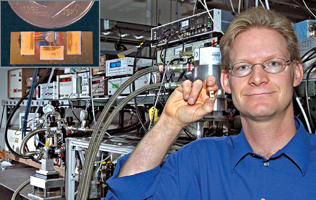
Working in the underutilised terahertz (THz) portion of the electromagnetic spectrum that lies between microwaves and infrared, a team of scientists is harnessing Sandia National Laboratories’ strengths in a variety of technical areas with the goal of building a highly integrated miniaturised terahertz transmitter-receiver (transceiver) that could make a number of applications possible.
"The technology being developed can be used to scan for items such as concealed weapons or materials, explosives, and weapons of mass destruction," says Mike Wanke, principal investigator. "In addition, we believe it will find applications in advanced communication systems and high-resolution radars."

Wanke says over the past three years, "the terahertz situation has begun to change dramatically, primarily due to the revolutionary development of terahertz quantum cascade lasers."
These new tiny lasers are semiconductor sources of terahertz radiation capable of output powers in excess of 100 mW. Previously, such powers could only be obtained by molecular gas lasers occupying cubic metres and weighing more than 100 kg, or free electron lasers weighing tons and occupying entire buildings. Quantum-cascade laser-based systems can be less than the size of a baseball and powered from a 9-volt battery. Sandia has been a leader in developing this new technology and along with MIT is responsible for several world performance records for the lasers.
With standard lasers, an electron in a high-energy state drops into a low-energy state, releasing the excess energy as a photon of light. In quantum-cascade lasers, the electron drops into a quantum well, emits a photon, and then moves through a thin barrier to the next well, where it emits another photon, and so on. The result is many more photons, and thus more-powerful t-rays.
The Sandia researchers are currently developing the receiver, doing systems tests and exploring packaging requirements. At the end of three years, they expect to have an actual working THz microelectronic transceiver prototype capable of detecting the materials and chemicals by reading distinctive molecular spectral 'signatures'.
"Most materials and chemicals have their own unique terahertz spectral signatures," Wanke says. "A terahertz transceiver system would be able to measure, for example, the signature of a gas and determine what it is."
"Atmospheric scientists and radio astronomers have spent years developing terahertz spectral signature databases to identify chemicals in nebula and planetary atmospheres," says Greg Hebner, program manager.
Although the current devices are washing machine-sized, the researchers are working on reducing the size, weight, and power requirement as well as expanding the existing spectral databases.
"We are very optimistic about working in the terahertz electromagnetic spectrum," Wanke says. "This is an unexplored area and a lot of science can come out of it. We are just beginning to scratch the surface of what THz can do."

© Technews Publishing (Pty) Ltd | All Rights Reserved